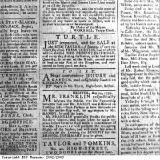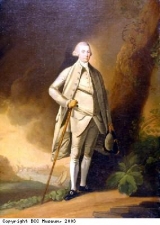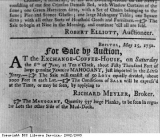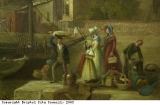Other plantation goods
Sugar and tobacco were the main goods brought into Bristol from the Caribbean plantations, but there were other luxury goods as well.
The alcoholic drink rum was made from one of the waste products of the sugar processing done on the Caribbean plantations. The cut canes of the sugar plant were crushed to extract the juice, and the juice was boiled until thick. The thick syrup was left to crystallise, and a treacle-like residue drained out of it. Rum was produced from this substance. It was imported to England in barrels alongside the barrels of sugar. Brandy from France may have been the preferred, more elegant drink. But rum was perhaps cheaper and, at times of war with France, more easily available and patriotic for the English drinkers.
Mahogany is a tree which produces a valuable wood. It grows in tropical climates, such as that of the Caribbean and South America. The dark red colour of the wood is very attractive. In the 18th century it became a fashionable wood for furniture. Mahogany was also used for making doors, door-frames, staircases, floors and panelling around rooms, as well as small decorative items. Wood often warps, or changes shape, as it dries out or as it reacts to changes in the environment. Mahogany did not warp much and so was ideal for fine furniture and for doors. Some mahogany trees grew on the Caribbean islands, and many were cut down in clearing the ground for the sugar plantations. Mainly the mahogany came from South America (especially the country of Honduras) and was shipped to Europe on the ships coming from the Caribbean. Once the wood had arrived in Bristol, it was often advertised for sale in newspapers such as the one shown here.
Trees and plants and their products were not the only luxury goods imported into England from the Caribbean. Turtles were also a delicacy. They were imported by ship, kept alive for the weeks of travel in tanks of water or wrapped in wet sheets. The Bristol newspapers often carried advertisements (such as the one pictured here) for a shipment of turtles arrived and for sale. They were killed as required. The meat was a great delicacy. It was cooked as meat (like a steak or chop, or ‘potted’ like pat’) and was used to make soup. The shell was used for decorative items. It was used, for example, to decorate small silver snuffboxes or pieces of furniture, or for hair combs or pieces of jewellery. Shown here is a detail from a painting titled View of the Avon. A man is carrying a turtle on his head, which has just been unloaded from a small rowing boat. The turtles have been unloaded from a ship. After being unloaded, the turtles were pulled through the streets of Bristol on sledges packed with straw to the kitchen of a house or inn.
The sort of luxury goods imported from the Caribbean to Bristol travelled far and wide. Bristol factories processed some of the imports such as sugar and tobacco before they left the city to be sold in shops. This portrait of William Prattinton was painted in about 1770. Prattinton was one of the leading merchants in Bewdley in Worcestershire, and had connections with Bristol. Amongst other things, he imported Caribbean goods from Bristol to Bewdley by river, up the Severn. From Bewdley such goods were sent to Prattinton’s customers in the West Midlands by packhorse and wagon. In the 1770s Prattinton was buying Caribbean mahogany in Bristol for the stairs and doors of the house he was building in Bewdley, 80 miles away.






